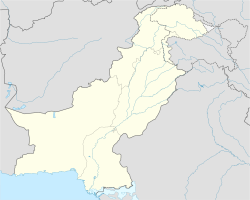| Sialkot International Airport سیالکوٹ بین الاقوامی ہوائی اڈا | |||
|---|---|---|---|
 | |||
 | |||
| IATA: SKT – ICAO: OPST | |||
| Summary | |||
| Airport type | Public | ||
| Operator | Sialkot International Airport Limited | ||
| Serves | Sialkot | ||
| Location | Sambrial | ||
| Elevation AMSL | 837 ft / 255 m | ||
| Coordinates | 32°32′08″N 74°21′50″E | ||
| Website | |||
| Runways | |||
| Direction | Length | Surface | |
| ft | m | ||
| 04R/22L | 11,811 | 3,600 | Asphalt |
Sialkot International Airport (IATA: SKT, ICAO: OPST) (colloquially known as Sialkot Airport) is situated 14 km (8.7 mi) west of Sialkot in the Sialkot District of Pakistan. Approximately 1,000,000 travellers from Sialkot and adjacent areas are expected to benefit from this international airport each year. Recently it has been confirmed that the airport will be developed further, the apron will be extended to accommodate 12 aircraft and jet bridges will be installed.
History
The export oriented industrial city of Sialkot had long felt the need of an international passenger and cargo airport. The nearest one was in Lahore which is about 125 km away. The federal government promised the industrialists of Sialkot an international airport but due to bureaucratic red-tape, indifference by the government and more importantly its proximity to Indian administered Kashmir and the periodic shelling from across the border, no work could be started. Finally, tired of foot-dragging, Sialkot's industrialists in the late 80's agreed to build the airport themselves and sought the federal government's approval. On February 2, 2001, approval was granted after a decade of negotiations with the federal government and construction of an international airport at Sialkot for passenger and cargo traffic began. A team of directors was approved, under the chairmanship of Mian Muhammad Riaz (CEO of Dr. Frigz International & three times chairman for SIAL) all of whom placed personal wealth into the project as a primary investment. Each director on the board had previous experience of running sizable and successful enterprises, therefore they were all selected due to this knowledge. Also, with Rs 5 million of personal investment in the project by each one of them, the directors had a direct stake in its profitability. As the development of SIAL went on, the number of directors had reached 250 and it was decided to close membership to the Board of Directors. The Board of Directors at SIAL inspired confidence that the potential of the airport project will be fully realized. On February 26, 2001, a Memorandum of Understanding (MoU) was signed between the Sialkot Chamber of Commerce & Industry and the Pakistan Civil Aviation Authority with the approval of Ministry of Defence for the construction of the international airport in Sialkot.
On March 24 2005, Sialkot International Airport Limited (SIAL) was formed under the auspices of the Chamber. On March 26, 2005, the first plane landed on the newly constructed runway, which has been built to handle a fully loaded Boeing 747 as future plans involved dealing with heavy aircraft for cargo imports and exports. PIA test flight PK-613 landed at the Sialkot International Airport on October 20, 2007.
A memorandum of understanding between PIA and Sialkot International Airport Authority for mutual cooperation and joint promotion of Sialkot International Airport was signed by Anwaar Rasul Khan, Senior Vice President (Sales), PIA, and Mian Naeem Javed, Director, Sialkot International Airport.
First and biggest ever international airport constructed in the private sector in Pakistan, at a cost of over Rs 2.6 billion became operational on November 30, 2007. Ex. President of Pakistan Pervez Musharraf formally inaugurated the Sialkot International Airport December 11, 2007; the country's first built by the private sector.
Structure
Sialkot is a major export hub of Pakistan. The airport is being upgraded to make it compatible to carry the load of three Boeing 747s. The airport authority is currently working with a private company to develop the airport to meet international standards. The airport has developed a brand new runway so heavier aircraft can land there. There is a new terminal currently being built to deal with increase in passengers as well as cargo imports and exports.
Services
Fuel farm
Aircraft ground maintenance services
Catering
Other related services through concessions to private parties.
Runway;
3,600 meter long, 45-meter wide with 7.5-meter wide shoulders on either side corresponding to International Civil Aviation Organization Category 4E.
Link Taxiway;
263-meter long, 23-meter wide with 10.5-meter shoulders.
Aprons;
For passenger and cargo, 95,000-Sq meter area. Combination of flexible and rigid pavements.
Nose-in parking for 10 wide-bodied aircraft at a time or 8 Airbus plus 4 F-27 aircraft at a time.
Airlines and destinations
Airlines Destinations
Pakistan International Airlines Jeddah, Dammam, Karachi, Kuwait, London-Heathrow, Muscat, Sharjah
Shaheen Air International Muscat, Sharjah
Cargo
Airlines Destinations
DHL International Aviation ME Dubai, Kandahar
Qatar Airways Cargo Doha
Transport links
Road
Travellers by car from Sialkot reach the airport by travelling west on the Sialkot-Wazirabad Duel Carriageway, turning off at Sambrial and then via Airport Road for 5 km to the airport. From the Gujranwala, take Sialkot Road, up to Daska and then Sambrial Road.
Bus
The airport can be reached from Sialkot up to Sambrial by Bus. Then you have to take a Taxi. An American bus company FOTON will provide airconditioned CNG Bus Service from airport to Sialkot, Wazirabad, Daska and Gujranwala.
Train
The nearest railway station is the Sambrial which is 5 km (3.1 mi) from the airport and is serviced by a taxi link.
(source:wikipedia)





